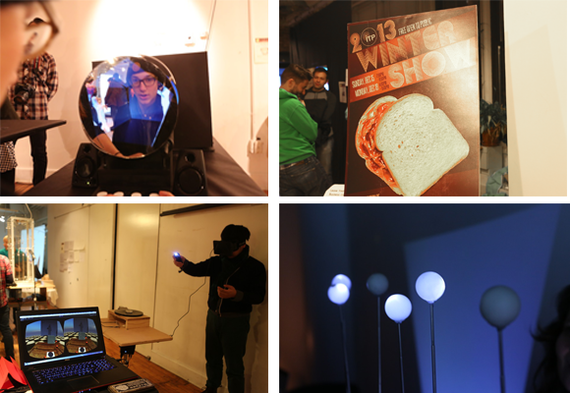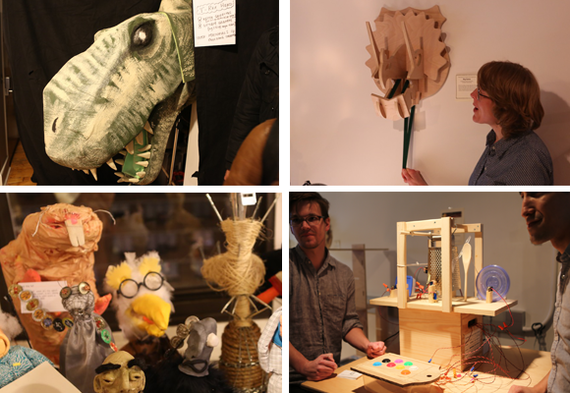Looking into the future is always tricky, but this year I'm more confident than in years past about where things are heading - and what lies ahead.
I began my journey into the future with trip to NYU's ITP Winter Show. ITP is a graduate program that melds art and science. Student's projects are focused on physical things - making ideas into objects that you can touch and explore. Over the years I'v found the ITP Winter Show to be a great way to see what students are exploring, without the limitations or barriers that companies and even startups sometimes face. ITP is pure creative thought made real.
This year's show was more playful, more childlike, in some ways more random than years past. A proliferation of toys, characters, even puppets filled 4th floor of the NYU loft classroom space in lower Manhattan. In years past, the ITP show was a festival of silicon, LED's and software. This year the most prevalent material was wood, followed closely behind by fabric. There were instruments, devices that mixed physical and electronic to make music - connecting user's hands to water, pyramids of sound, even clanking kitchen objects.
![2013-12-26-ITP1.png]()
If there was an overarching change from shows past, this one was much less commercial - with few ideas that seemed like they were headed for a life as a business. Rather, these were explorations of art, ideas, forms, and materials. Weavy was listed as "The Smart Loom" by Kristina Budelis, Danqing Wang, Pamela Liou, and Tan Ma. The idea was to teach weaving. The push of a button operates motors to automate the loom for new students. "Origami Fabrics" by Anne-Marie Lavigne were incredibly rigid objects made in fabric, inspired by origami folds. And the social issues of the day were represented by "NYC: FRSK04" a robot that automated the controversial NYC "Stop and Frisk" practice by students Sam Lavigne & Fletcher Bach.
![2013-12-26-ITP2.png]()
There were exceptions of course. NapChat (bit.ly/napchat) was a cuddly child's doll that can have its audio programed remotely so parents out of town can record bedtime stories. Expect this is ToysRus by next Christmas.
But overall this years ITP let business and tech take a back seat - as art, exploration, music, and storytelling stepped up. What does this mean? That students are feeling more confident in their ability to get jobs, and don't need ITP to be a place to focus group business ideas? That's one impression. Another is that technology, for tech's sake, is now blending into the background Yes, we can make it blink, or spin, or talk - but so what? This years ITP show felt more organic, more real, more edgy, and less formed. Overall, more raw... in a good way.
I began my journey into the future with trip to NYU's ITP Winter Show. ITP is a graduate program that melds art and science. Student's projects are focused on physical things - making ideas into objects that you can touch and explore. Over the years I'v found the ITP Winter Show to be a great way to see what students are exploring, without the limitations or barriers that companies and even startups sometimes face. ITP is pure creative thought made real.
This year's show was more playful, more childlike, in some ways more random than years past. A proliferation of toys, characters, even puppets filled 4th floor of the NYU loft classroom space in lower Manhattan. In years past, the ITP show was a festival of silicon, LED's and software. This year the most prevalent material was wood, followed closely behind by fabric. There were instruments, devices that mixed physical and electronic to make music - connecting user's hands to water, pyramids of sound, even clanking kitchen objects.

If there was an overarching change from shows past, this one was much less commercial - with few ideas that seemed like they were headed for a life as a business. Rather, these were explorations of art, ideas, forms, and materials. Weavy was listed as "The Smart Loom" by Kristina Budelis, Danqing Wang, Pamela Liou, and Tan Ma. The idea was to teach weaving. The push of a button operates motors to automate the loom for new students. "Origami Fabrics" by Anne-Marie Lavigne were incredibly rigid objects made in fabric, inspired by origami folds. And the social issues of the day were represented by "NYC: FRSK04" a robot that automated the controversial NYC "Stop and Frisk" practice by students Sam Lavigne & Fletcher Bach.

There were exceptions of course. NapChat (bit.ly/napchat) was a cuddly child's doll that can have its audio programed remotely so parents out of town can record bedtime stories. Expect this is ToysRus by next Christmas.
But overall this years ITP let business and tech take a back seat - as art, exploration, music, and storytelling stepped up. What does this mean? That students are feeling more confident in their ability to get jobs, and don't need ITP to be a place to focus group business ideas? That's one impression. Another is that technology, for tech's sake, is now blending into the background Yes, we can make it blink, or spin, or talk - but so what? This years ITP show felt more organic, more real, more edgy, and less formed. Overall, more raw... in a good way.